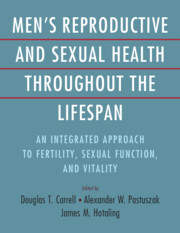 Men's Reproductive and Sexual Health Throughout the Lifespan
Men's Reproductive and Sexual Health Throughout the Lifespan from Section 1 - An Introduction to Men’s Health Care
Published online by Cambridge University Press: 06 December 2023
In this chapter, we will review how men’s health has evolved into a distinct subspecialty of medicine and changed over the past two decades. There exists a large disparity between men and women when it comes to health. However, as the drivers for men seeking health care are changing, the urologist is in a unique position to help quarterback men’s health initiatives. Men’s health advocacy and the creation of men’s health centers are on the rise. Areas of advancement in the field include prostate cancer diagnosis and treatment, erectile dysfunction therapies, surgical treatment for chronic testicular pain, and new approaches to male factor infertility. The burgeoning field of men’s health has seen many advancements in the past two decades and will continue to make significant gains in the years to come.
To save this book to your Kindle, first ensure no-reply@cambridge.org is added to your Approved Personal Document E-mail List under your Personal Document Settings on the Manage Your Content and Devices page of your Amazon account. Then enter the ‘name’ part of your Kindle email address below. Find out more about saving to your Kindle.
Note you can select to save to either the @free.kindle.com or @kindle.com variations. ‘@free.kindle.com’ emails are free but can only be saved to your device when it is connected to wi-fi. ‘@kindle.com’ emails can be delivered even when you are not connected to wi-fi, but note that service fees apply.
Find out more about the Kindle Personal Document Service.
To save content items to your account, please confirm that you agree to abide by our usage policies. If this is the first time you use this feature, you will be asked to authorise Cambridge Core to connect with your account. Find out more about saving content to Dropbox.
To save content items to your account, please confirm that you agree to abide by our usage policies. If this is the first time you use this feature, you will be asked to authorise Cambridge Core to connect with your account. Find out more about saving content to Google Drive.